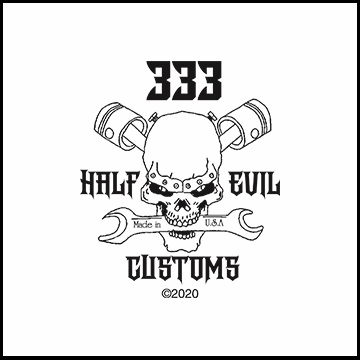I was going to reply to your private message, but as I was typing this out I realized there's a lot of good info here that I really wish I'd had a few months ago when I started pulling my case apart, so I'm just going to put it out here in public in case anyone else can also use the info...
Regarding the shocks, no, I didn't even know they come apart. I have a couple sets, so I just picked the ones that felt the stiffest and put them back on the bike... although some day I might get some nice progressives to replace them.
Start with putting the transmission in neutral... you'll want to note the position of things once the case is split. Also check for bolts on both the top and bottom of the case before you start trying to split them.
Really it's not hard, but if the case halves have a good seal that it takes a bit to get them started. It's about the same with getting the oil pan off, you just have to find a corner where you can start pulling the pieces apart without damaging the outer fins or anything else. If your case has the original paper gasket, it gives you a little space to get in there with a fine flat blade. I think I basically started going around the outside of the case, finding offset fins to pry against or other pieces where I could get some leverage, and just kept working it slowly until one of the corners finally started coming loose. Once you get a small gap started then it gets a lot easier to work from there, getting a flat putty knife between the gap to apply a little more leverage. The main thing to always keep in mind is to not apply pressure in such a way that it might damage the mating surfaces.
Once you get the oil pan off, take out the oil pump. When the case halves come apart, keep the case upside-down, and there are four bolts on the center crank cap to remove. Then you can lift out the whole crank (you may need the ring compressor on the outer two pistons). There are positioning pins in some of the bearing, so watch out for those when you remove the crank. Take them all out, because as you clean the case they'll end up falling out anyway.
There are two rods of gears for the transmission. Note that beside the shifter rod there is a disc with a black center, and there should be a notch or painted mark around one edge. You'll want to record the position of that mark so you can put the tranny back in neutral when you reassemble. (The position shown in my manual was off by about 30 degrees, so I had to find it myself.) There are three forks sitting in slots between the gears, two on one rod and one fork on the other. With the transmission in neutral, you should be able to freely spin the output shaft where the chain sprocket goes. Each of the forks has a pin that sits in slots inside the larger center bar. Just look over how things fit together, or take pictures if needed. At this point you can lift out those two clusters of gears from the case. Each of these has what looks like half of a piston ring that fits a slot in the bearings and the top half of the case -- again remove these and set aside or they'll fall out while cleaning.
There are also centering pins between the cases, one in front and one at the rear, and more of these pins around the sides. Some will be loose and others stuck tight. I would highly suggest taking pictures of all the locations where you have these pins so you can get them all back in later. There are different sizes, but they are interchangeable within the same diameters, however one side has a square shoulder and one side is rounded. When you put them back together, the rounded side should be out.
Another thing to watch for, there are one or two black plastic washers between some of the oil passages that run between the case halves. Otherwise you should be done now. You may decide to pull apart the mechanism from the outside of the case that handles gear changes. I pulled mine apart, but I had another unit sitting beside me to reference for putting it all back together again. I wouldn't do it again unless I really had to.
At this point I hit the case halves with some engine degreaser, let it sit, then hosed it down. Then use a putty knife to scrape off the obvious thick layers of grease, and hit it with the degreaser again. I find that with the lower power of my sandblaster, the sand just bounces off these grease layers, so it saves me a lot of time by getting down to bare metal manually.
After you finish painting and baking the pieces, you want to take them outside and hose them down. Spray water into every last channel, nook, and cranny you can find. Sand will be everywhere, and you don't want to leave anything behind. Don't forget to pull off the cap on the side of the case that covers a big oil passage. When you think you have everything clean, spray it down again. I kept going on each piece until I didn't see a single grain of sand coming out of any spots. Shake the pieces dry, blow out water with an air compressor if you have one, then let them sit for at least another day or two before you start putting them back together. You don't want to have any water left inside the case when you add the oil.
Now you're ready to put all the centering pins back into their holes, replace the internal oil passage seals, drop in the pins for the crank and the half-round rings for the transmission bearings. Put the crankshaft back in place, again using ring compressors on the outside two pistons as needed (I tried to wedge mine through without compressors and broke a ring in the process). There is an arrow on the center crank cap that should point towards the front. Make sure you torque down these bolts in order of the numbers marked on the cap... if you forget to torque them, you'll never be able to get to them without splitting your case again! After that, drop the transmission gears back in place, making sure the gears are in their neutral position. All of your surfaces should be oil-free, but if you're using a liquid gasket you'll want to prep the mating surfaces with some 220 sandpaper, very lightly scoring the surfaces without rounding them off. This gives something for the liquid gasket to bite in to. Before actually applying the gasket, you should practice placing the case back together and fitting the forks back into their slots. With everything together you can shift between 1st and neutral, but you have to give the output shaft a good spin to shift up into second gear. Make sure you can shift through the whole range smoothly (keeping in mind there is no oil in there right now so it will be a bit stiff). Once you have verified everything is working properly, put it back in neutral and remove the bottom half. You're now ready to apply your gasket and do the final assembly. Keep your liquid gasket sealer very thin, once finished it will be paper thin but you want to apply enough that it fully covers the surfaces once it squishes out.
At this point you're going to have a pile of several different lengths of bolts for your case halves. The trick to remember (and this has been true of every engine I've worked on) is that when you drop the bolts into the holes, they will ALL be sticking out the same amount regardless of their actual length. For the case halves, they were all sticking up about half an inch. Note that there are a couple bolts on the case where you want to apply more liquid gasket sealer underneath the head (check your manual). Tighten down the bolts loosely by hand, then work them down to full torque in a couple steps. DO NOT OVER-TIGHTEN! These bolts require very little force to reach torque. For mine, it was only 90 inch-pounds or 7.5 foot pounds. I can easily double that by hand, so don't go crazy when you initially seat them.
The oil pan will be the same process. Get the oil pump put back in and torqued, put in the large O-ring around the oil filter hole, and get your gasket in place. Again you will have bolts of various lengths, but they all stick up the same amount when sitting in the correct holes. Torque them down in multiple steps, then let everything sit overnight so the gasket sealer dries. Finish off your oil plug and oil filter assembly, and you're ready to flip the engine back right side up.
Hope that helps, let me know if you need more details about anything...



